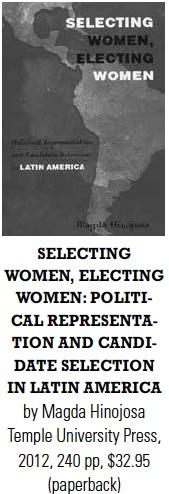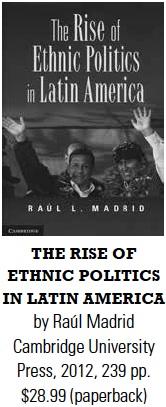Over the past 15 years or so, the concept of citizenship has become increasingly broad in Latin America. Thanks in large part to democratization in the 1990s, previously excluded populations, from indigenous groups in Ecuador and poor people in Bolivia to women in Argentina, have gained substantial rights. Governing the Americas these days just ain’t what it used to be, what with all these newly empowered sectors of society clamoring for recognition, cultural protection, political participation—sometimes even leadership positions (ye gads).
The general—though far from universal (remember Honduras’s 2009 military coup?)—“opening up” of Latin American society has produced an explosion of scholarly literature on social inclusion in the region. This essay reviews four recent books examine the tactics, achievements, and challenges of women, indigenous peoples, Afro-descendants, and LGBTQ communities as they shoulder their way into the Latin American political sphere.
1496
Selecting Women, Electing Women, Magda Hinojosa’s discerning exploration of women in Latin American politics, opens with a series of female success stories. In 2006, Chile elected Michelle Bachelet president. Then came the wins of Cristina Fernández de Kirchner in Argentina (2007), Dilma Rousseff in Brazil (2010), and Laura Chilchilla in Costa Rica (2010). And they’re not the first modern Latina leaders: In the 1990s both Nicaragua and Panama elected female heads of state (Violeta Chamorro and Mireya Moscoso, respectively). Not too shabby for the region that coined the term machismo.
A chart in Chapter 1 shows that nearly every Latin American nation has markedly increased its fraction of female legislators since 1980. Three decades ago, many places had exactly zero female senators. By 2010, percentages had spiked to 47% in Bolivia, 35.5% in Argentina, and 32% in Ecuador. In comparison, today less than 20% of the U.S. Congress is composed of women.
So what sea change ushered Latin American women into influence? That’s an interesting question, but it’s not Hinojosa’s point. “The fact that [Bachelet et al.] . . . have been elected to their nations’ . . . most visible office should not obscure the unequal gender balance in politics,” she warns. The rest of the book’s 170 pages strive to determine why “[w]omen in the region remain inadequately represented at all levels of politics,” occupying just one in seven legislative seats and one in 20 mayoral posts.
To sort out this puzzle, Hinojosa examines candidate-selection dynamics, contending that this under-studied and distinctly unsexy process is the central factor limiting women’s leadership. She handily disproves the leading explanations for female under-representation, refuting both supply-side arguments (i.e., there aren’t enough qualified women running for office) and demand-side excuses (i.e., people won’t vote for a woman) with a parade of data on women’s progress. Nearly everywhere in Latin America, women’s literacy is approaching men’s, and female workplace participation has tripled since 1960. While some gender-based voter bias does remain, it is diminishing and unable to thoroughly sideline women.
Therefore, concludes Hinojosa, the “bottlenecks . . . occur in the second and third stages” of the path toward office: “when eligibles become aspirants and, later, as aspirants transform into candidates.” Selecting Women, Electing Women supports this claim primarily with detailed case studies on Chile and Mexico, drawing the surprising conclusion that it may in fact be the primary process—often thought of as the most democratic of all nominating systems—that keeps Latin American women disempowered.
1494
The story is a happier one for indigenous peoples, whose political star has risen markedly in recent years, pronounces Raúl Madrid in The Rise of Ethnic Politics in Latin America. From Bolivia’s election of the Aymara unionist Evo Morales to Ecuador’s new “multicultural” constitution, the 21st century has seen indigenous issues move into the forefront of political consciousness, at least in the Andean region.
Through an in-depth parsing of electoral data from Ecuador, Bolivia, and Peru, Madrid seeks to explain how this shift—which is little short of miraculous after four centuries of elite white rule—transpired. His topic is ethnicity, but he understands that race in a mestizo continent is a fluid thing, and judiciously allows for crosscutting identities. The result is a work that is nuanced and credible, as well as adeptly written.
Madrid argues that the election of indigenous presidents in Latin America did not result from some groundswell of support for its indígenas but rather a hybrid movement he dubs “ethnopopulism.” Evo Morales founded MAS as an indigenous party, yes—but he also championed pro-poor policies; Peru’s Ollanta Humala was a Quechua candidate of a traditional party, Union por el Perú, who also made indigenous appeals. In both cases, Madrid argues, indigenous mobilization took on an unanticipated populist character, whereby candidates wooed not just their ethnic cohort but also peasants, the urban poor, and other marginalized sectors. MAS leaders “employed nationalist and anti-imperialist rhetoric”; Humala “rail[ed] against the traditional parties, the legislature, and the political class….”
The book leaves readers uncertain how to feel about the ethnopopulist trend. On one hand, “both the MAS and Ecuador’s Pachakutik have actively recruited white and mestizo candidates and have developed broad and inclusive platforms,” ensuring ethnic politics won’t destroy Latin America as they did Yugoslavia. Yet their effect on institutions has been mixed. As populism often does, ethnopopulism in the region, argues Madrid, has “weakened democracy” and “undermined the rule of law.”
1495
The relative success of indigenous groups stands in contrast to the enduring marginalization of Afro-descendants. With Racial Subordination in Latin America: The Role of the State, Customary Law, and the New Civil Rights Response, Tanya Katerí Hernández joins a small but devoted group of English-language scholars bringing to light the historic oppression and present-day struggles of this community of 150 million, whose enslaved ancestors played a formative role in Latin American nation-building, society, and culture.
Hernández’s book begins by eviscerating the myth of racial democracy that prevails in Latin America—that is, the notion that Latinos, by virtue of being majority mestizo, cannot possibly be racist. This trope of “racial innocence,” as Hernández calls it, ignores a legacy of racial inequality that traces back to slavery. Her aim is to expose how Latin American society has invoked seemingly egalitarian national ideologies to maintain white supremacy, disguising powerful barriers to Afro-descendant progress.
She does so persuasively, making good use of statistical information, case studies, linguistic analyses of the colloquialism negro, and historical immigration laws. Hernández’s findings are telling: Across the board, Afro-Latinos experience socioeconomic disadvantage (80% of Afro-Colombians subsist below the poverty line), social exclusion (Afro-Latinos are “disproportionately illiterate”), and political under-representation (in biracial Uruguay, just one congressman is black).
The good news comes in Chapter 5, which details regional advances in racial justice. Mounting domestic activism and a 2001 United Nations conference on racism have spurred governments into passing anti-discrimination legislation, including criminalizing racist displays (Peru), prohibiting employment discrimination (Mexico), and protecting cultural diversity (Colombia). In Brazil, President Henrique Cardoso established quota-based affirmative action in universities and federal agencies, a policy Dilma Rousseff is expanding.
Among the book’s novel contributions is its linking of racial-democracy myths in North and South America. “President Obama’s election in 2008 is viewed as the culmination of U.S. racial transcendence,” writes Hernández in her conclusion, “so that now the United States presents itself as ‘racially innocent’ in much the same way Latin America has long claimed to be.”
Cross-cultural comparison is at the heart of Rafael de la Dehesa’s Queering the Public Sphere in Mexico and Brazil: Sexual Rights Movements in Emerging Democracies, which analyzes the tactics of the LGBTQ coalitions in Mexico and Brazil in achieving same-sex marriage and anti-discrimination laws.
The title of the introductory chapter, “Hybrid Modernities, Modern Sexualities,” should give readers a hint of the dense critical queer theory that’s coming. Brandishing such phrases as “hegemonic transnational identities” and “polyvalent sexual landscapes,” de la Dehesa’s prose is noun-laden and comma-happy.
Despite occasional clunkiness, the author’s history of homosexuality in Brazil and Mexico is lively. For example, homosexual acts have never been illegal in either country—though that didn’t stop the police from consistently and creatively repressing men who “flaunted” their sexuality. In a Rio de Janeiro “cleanup operation” in the 1950s that apparently equated tight pants with homosexuality, “officials would drop an orange down the pants of a suspect, and if it did not come out the bottom, the suspect . . . was subject to detention.”
By the 1970s, leftist groups in both Brazil and Mexico had shattered the public-private divide by broaching public debates on homosexuality. Here, they were taking their cue from the gay-rights movement in the United States. It is in this era that a transnational “gay identity” emerged and, with it, the international rights discourse that eventually led to anti-discrimination laws around the globe, including in Brazil and Mexico. De la Dehesa shows how LGBTQ advances in Brazil and Mexico emerged, in part, from the convergence of national and international activism.
He is right, of course. Gay people, like women, Afro-descendants, and indigenous communities, have achieved full(er) citizenship thanks in no small part to the international rights agenda and the identity politics of liberal democratic societies. But there’s an important footnote here: In recent years, hate crimes against homosexuals in Brazil have spiked drastically, and gender quotas in Argentina’s congress have led some to perceive female leaders as mere proxies of their husbands (the so-called mujeres de phenomenon), undermining their credibility. Top-down changes in policy do not necessarily lead to cultural shifts. But in Latin America, as these authors show, today the grassroots are rising to the challenge.
Catesby Holmes is NACLA's Circulation and Outreach manager.
Read the rest of NACLA's Winter 2012 issue: "Elections 2012: What Now?"

